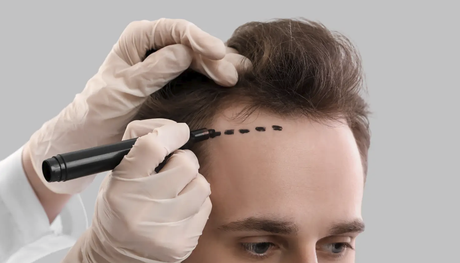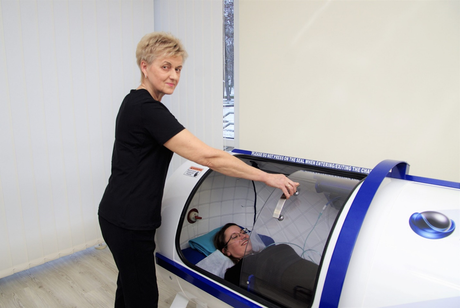One of the cosmetic surgical therapies that are advancing the fastest is hair transplantation, which frequently sees advancements in its methods. This therapy has reached a new level as a result of recent technological developments and the idea of employing follicular unit grafts. Many balding men and women have chosen this surgical procedure because it can produce very natural-looking results.
In hyperbaric oxygen therapy, the individual breathes 95% oxygen while inside a pressurized chamber three times the pressure of the surrounding air. For effectiveness, the pressure must be at or above 1.4 ATA. HBOT is becoming more widely accepted in human medicine. Different principles are used in hyperbaric therapy to explain how gases react to pressure, specifically how oxygen behaves under higher pressure. The primary concept of HBOT is that the deeper tissue penetration is caused by the higher oxygen concentration under pressure. Growing oxygen levels eventually have physiological repercussions that could change how tissues react to illness or injury.
Hyperbaric oxygen therapy has been used for many years to achieve positive results. It was first used many years ago. It has been used to treat non-healing wounds or decompression sicknesses. Hyperbaric oxygen therapy is popular among professional players for treating sports-related injuries such as torn muscles, sprains, or ligaments in order to enable a speedy return to play. Transplanted hair follicles experience a variety of problems that are challenging to avoid. It has been claimed that hyperbaric oxygen therapy (HBOT) is a highly effective method for encouraging capillary regeneration and minimizing ischemia-reperfusion harm.
Therapeutic basis of HBOT:
The following three key factors all impact the therapeutic basis of hyperbaric oxygenation: (1) A favorable gradient is formed by inhaling 100% oxygen, encouraging diffusion from hyper oxygenated influences the quality of lungs to hypoxic regions.(2) According to Henry’s Law, which states that the amount of dissolved gas in a liquid is in direct proportion to its partial pressure, the high pressure causes the blood’s O2 proportion to increase.(3) Boyle-Mariotte Law and Henry’s Law are used to describe how the gas bubbles in the blood get smaller. In other words, the introduction of a hyperbaric environment with pure oxygen permits a significant increase in the oxygen supply to the blood (hyperoxia) and tissues even without the aid of hemoglobin (hyperoxia). As a result, HBOT has a range of physiological effects and has the potential to control a variety of pathological processes, including wound repair, cytotoxicity, and ischemia injuries, as well as to treat chronic hypoxia and tissue hypoperfusion
Pathological stress that is predominantly brought on by hypoxia in cells is directly linked to the initiation and development of a wide spectrum of illnesses. This has led to the idea that oxygen might be used as a medicinal agent for those suffering from a number of acute or chronic ailments. Since treating cellular hypoxia is a potential but novel method, clinical management of hypoxia focuses on controlling hypoxemia and oxygen transport within the tissues. HBOT becomes a valuable tool for treating hypoxia and other illnesses associated with hypoxia by increasing the oxygen levels in the blood and tissues.

Mechanism of HBOT as adjunctive therapy in Hair transplant:
The potential of HBOT to lessen postoperative follicle shedding and produce less folliculitis and itchiness provides support for its usage as adjunctive treatment following hair transplant surgery. Postoperative recovery time has drawn more attention as hair transplantation technology has developed, along with the volume and overall survival of transplanted hair follicles.There is presently no effective preventative therapy for the transplanted hair follicles’ shedding phase. Hyperbaric oxygen can slow the rate at which transplanted HFs shed. Three factors could be involved in this.
● First of all, early postoperative ischemia, or a lack of oxygen, which prevents many of the cell’s normal metabolic processes from occurring normally and prevents mitochondria from maintaining their structural integrity, was caused by the injury caused by surgery in both the recipient site and the transplanted HFs.Several metabolites build up in the cells at the same time, which causes damage to the cells. While providing oxygen for normal metabolic functions, HBOT can significantly boost oxygen’s partial pressure, enhance tissue perfusion and oxygenation, and boost tolerance to ischemia. Hyperbaric oxygen therapy may also enhance VEGF expression, which can encourage the production of nitric oxide (NO), which has the effect of vasodilation and raises the oxygen partial pressure in the target areas.
● Second, ischemia causes transplanted hair follicles to become malnourished because they cannot receive enough nutrition and growth factors from the adjacent tissue fluid to stop hair loss. HBOT made in a hyperbaric oxygen chamber, may increase collagen production and deposition and VEGF expression, two factors supporting angiogenesis. Better oxygenation and nourishment supply and earlier blood vessel formation can reduce the risk of damage to transplanted Hair follicles.
● Thirdly, reactive oxygen species are also produced when the blood supply to the HFs gradually improves. These species can harm DNA double strands and cell membranes through lipid peroxidation, which in turn results in cell death. Microvessel constriction and neutrophil adhesion and infiltration will take place simultaneously. The hair follicles sustain reperfusion harm after being injured. However, HBOT can also prevent or lessen harm brought on by reactive oxygen species, neutrophil adhesion/infiltration, and microvascular vasoconstriction. Additionally, HBOT might increase TGF-1 release, which upregulated bcl-2 and prevent fibroblast apoptosis, and TNF-expression, hence reducing reperfusion injury. Due to these factors, HBOT may be used as an adjunctive therapy to enhance postoperative shedding.

HBOT Improves Folliculitis and Itching:
Postoperative issues from hair transplantation can include folliculitis and itching. The incidence of folliculitis and itching was substantially reduced in those who had HBOT. This might be connected to HBOT’s capacity to fight infections. Folliculitis and itchiness may be connected to infection (local tissue hypoxia may cause wound infection), and hyperbaric oxygen therapy can improve neutrophil and lymphocyte function, increasing the body’s defense mechanism.
The best hyperbaric chambers for use at home are those made by OXYHELP since they contain characteristics that reduce the possibility of developing any risks from personal use. They provide their specialists on-site for installation and maintenance as well as online support for its customers all over the world.
